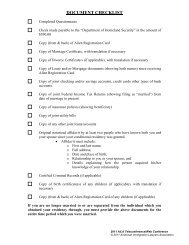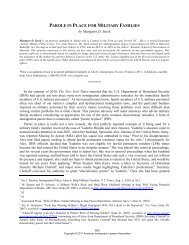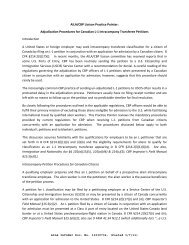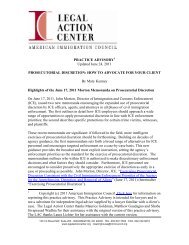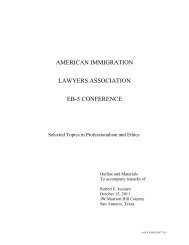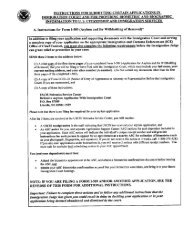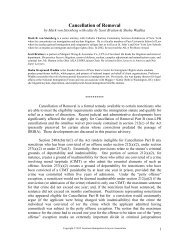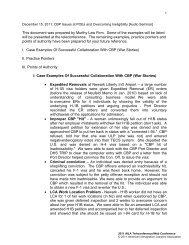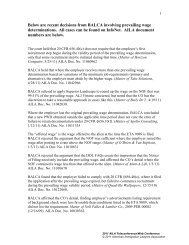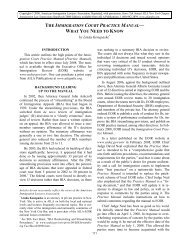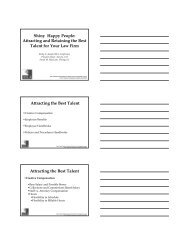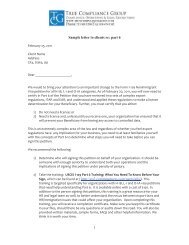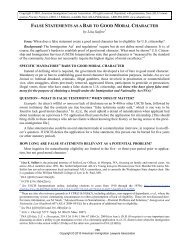Resources for 02-09-12 Seminar - AILA webCLE
Resources for 02-09-12 Seminar - AILA webCLE
Resources for 02-09-12 Seminar - AILA webCLE
You also want an ePaper? Increase the reach of your titles
YUMPU automatically turns print PDFs into web optimized ePapers that Google loves.
EFFECTIVE ADVOCACY FOR RELIGIOUS WORKERS<br />
by Joel Pfeffer, Michelle L. Lazerow, Mary M. O’Leary, and Elizabeth Rompf Bruen *<br />
updated by Joel Pfeffer, Cliff Rosenthal, and Michael Runde<br />
Joel Pfeffer is a partner of the Pittsburgh law firm of Meyer, Unkovic & Scott LLP. A 1985 graduate of the University of Pittsburgh<br />
School of Law, he practices in the areas of immigration, nationality, and corporate law. Mr. Pfeffer is active in <strong>AILA</strong> and has served<br />
as a member of the Religious Worker Committee, the Finance Committee, and as speaker and Chapter Chair.<br />
Cliff Rosenthal specializes in the business, entertainment and family immigration law field with the Wolfsdorf Immigration Law<br />
Group. He is the <strong>for</strong>mer Chair of <strong>AILA</strong>’s Religious Worker Committee and currently serves as a member of <strong>AILA</strong>'s Health Care<br />
Professionals and Physicians Committee. He is listed in Who's Who Legal in Corporate Immigration.<br />
Michael C. Runde practices with Hochstatter, McCarthy, Rivas & Runde, S.C. Mr. Runde is past Chair of <strong>AILA</strong>’s Wisconsin<br />
Chapter and has served on a number of <strong>AILA</strong> committees. His practice is concentrated in employment immigration, with an emphasis<br />
on religious worker matters. He has participated as faculty on religious worker panels at <strong>AILA</strong> conferences. He is a past member of<br />
the <strong>AILA</strong> Religious Worker Committee. Mr. Runde is listed in Best Lawyers of America, Super Lawyers, and Who’s Who Legal in<br />
Corporate Immigration.<br />
**********<br />
On November 26, 2008, the U.S. Citizenship and Immigration Services (USCIS) issued new regulations<br />
implementing changes to the way immigration petitions <strong>for</strong> religious workers are adjudicated. The purpose of<br />
these changes was outlined by USCIS in its introduction when it stated, “USCIS is implementing [these]<br />
requirements … to allow the federal government, as well as religious organizations, to better detect and deter<br />
fraud or other abuses of the religious worker program without compromising the many contributions made by<br />
nonimmigrant and immigrant religious workers to religious organizations in the United States.” 1 Representing<br />
religious workers and organizations in this dubious environment presents challenges; however, careful case<br />
* The original version of this article was published in Immigration Practice Pointers 264 (<strong>AILA</strong> 2011-<strong>12</strong> ed.).<br />
Joel Pfeffer is a partner of the Pittsburgh law firm of Meyer, Unkovic & Scott LLP. He practices in the areas of immigration,<br />
nationality, and corporate law. Mr. Pfeffer is active in <strong>AILA</strong> and has served as a member of the Religious Worker Committee, the<br />
Finance Committee, and as speaker and chapter chair.<br />
Michelle L. Lazerow practices immigration law in the Washington, D.C., metropolitan area, primarily in the areas of business,<br />
family, and naturalization. She has served on numerous <strong>AILA</strong> liaison committees on both local and national levels and on numerous<br />
conference committees as chair, co-chair, and committee member. She has participated as a panelist on a large variety of immigration<br />
issues in conferences nationwide. Ms. Lazerow served six years on the board of the American Immigration Law Foundation, as chair<br />
of the Annual Immigrant Achievement Awards (D.C.) <strong>for</strong> 11 years, and as chair of the Immigrant Achievement Awards (Annual<br />
Conference, Utah). Ms. Lazerow graduated with a law degree and a postgraduate degree in corporate law from University of the<br />
Witwatersrand, Johannesburg, South Africa, and holds an LL.M. from George Washington University, Washington, D.C.<br />
Mary M. O’Leary is the principal in the Law Office of Mary O’Leary. Ms. O’Leary is a 1999 graduate of DePaul University<br />
College of Law and was admitted to the Illinois Bar in November 1999. She earned an M.A. in Latin American Studies from the<br />
University of Chicago in 1992 and a B.A. from Alma College in 1991. Ms. O’Leary has served the immigration bar on numerous<br />
committees and is a frequent speaker on a variety of immigration law topics, presenting to professional and community organizations.<br />
Ms. O’Leary has a general immigration law practice.<br />
Elizabeth Rompf Bruen is an immigration attorney with Scott D. Pollock and Associates, P.C., in Chicago. Ms. Rompf Bruen<br />
represents clients in all areas of immigration law and was named a Rising Star in immigration law by Super Lawyers. She is an active<br />
member of <strong>AILA</strong> and currently chairs the Chicago Chapter’s liaison committee with the Executive Office of Immigration Review.<br />
Ms. Rompf Bruen graduated with honors from DePaul College of Law in Chicago and the University of Notre Dame in Notre Dame,<br />
Indiana.<br />
The authors wish to thank Carlos Ortiz-Miranda <strong>for</strong> his thoughtful suggestions regarding this article.<br />
1 See Special Immigrant and Nonimmigrant Religious Workers; Special Immigrant Nonminister Religious Worker Program<br />
Act; Final Rule and Notice, 73 Fed. Reg. 72277 (Nov. 26, 2008) and published on <strong>AILA</strong> InfoNet at Doc. No. 081<strong>12</strong>230<br />
(posted Nov. 22, 2008).<br />
Copyright © 20<strong>12</strong> American Immigration Lawyers Association
EFFECTIVE ADVOCACY FOR RELIGIOUS WORKERS<br />
planning, detail-oriented preparation, thorough documentation, and thoughtful advice throughout the process<br />
should alleviate USCIS’s fraud concerns, effectuate successful adjudications <strong>for</strong> immigration attorneys’<br />
clients, and serve as constructive advocacy <strong>for</strong> future religious workers and organizations.<br />
CASE-PLANNING AND PREPARATION<br />
Clear documentation of each element of the statute and regulations establishes the nature of the petitioning<br />
organization and the beneficiary’s qualifications. USCIS provides document checklists on its website with<br />
specific examples of evidence it finds appropriate to establish the required elements. 2<br />
The Employer<br />
Tax-exempt Status<br />
USCIS, in comments to the November 26, 2008, final rule, stated that it viewed the determination letter to<br />
be a “valuable fraud deterrent” that “provides a petitioning organization with the opportunity to submit<br />
exceptionally clear evidence that it is a bona fide organization.” 3 Additionally, the regulations make clear that<br />
only an Internal Revenue Service (IRS) determination letter identifying the organization as a nonprofit<br />
organization under Internal Revenue Code (IRC) §501(c)(3) is acceptable; a tax-exempt determination under<br />
IRC §501(d), 26 USC §501(d), will not qualify an organization to file nonimmigrant and immigrant petitions<br />
<strong>for</strong> religious workers. 4 USCIS acknowledges that determination letters do not expire; it will accept<br />
determination letters from any date, but may seek more recent evidence to confirm that the exemption is still<br />
valid. There<strong>for</strong>e, where the petitioning organization has an IRS determination letter with an older date, it is<br />
wise to include some more recent evidence of tax-exempt status, such as filings with the IRS, to maintain taxexempt<br />
status. Moreover, if you have any question whether the organization’s tax-exempt status is still valid,<br />
you may refer to IRS Publication 78 to verify that the organization is still listed as a tax-exempt organization. 5<br />
USCIS states that it is important to establish the nexus between the petitioning organizations and the<br />
beneficiary’s employee location to ensure that the location where the beneficiary will work is part of the<br />
petitioner’s organization. Tax exempt status of the petitioning organization and the beneficiary’s location is<br />
one of the indications to establish such connection. 6<br />
Practice Pointer: Obtain the employer’s federal employer identification number and a determination letter<br />
from the IRS verifying the tax-exempt status of the petitioning religious organization under Internal Revenue<br />
Code §501(c)(3), 26 USC §501(c)(3).<br />
Practice Pointer: Catholic organizations have a unique mechanism to demonstrate both their tax-exempt<br />
status and the organization’s membership in the denomination. Since 1946, the IRS has annually issued a<br />
letter to the U.S. Conference of Catholic Bishops regarding its group ruling. The group ruling letter means<br />
that any organization listed in the most recent edition of the Official Catholic Directory is covered by the<br />
group’s tax-exempt ruling. 7 Submission of a copy of the most recent version of the IRS group ruling letter<br />
along with a copy of relevant page of the Official Catholic Directory is sufficient to demonstrate tax-exempt<br />
status and membership in the denomination. The Official Catholic Directory has a U.S. directory and an<br />
international directory—the latter listing dioceses throughout the world—that can be helpful in documenting<br />
membership in the worldwide Catholic Church.<br />
2 See www.uscis.gov/files/<strong>for</strong>m/m-737.pdf. In addition, questionnaires, such as the attached, assist employers and beneficiaries<br />
in gathering required in<strong>for</strong>mation and documentation.<br />
3 73 Fed. Reg. 72280.<br />
4 The regulations note that if an organization is tax exempt under IRC §501(d) rather than §501(c)(3), the organization cannot<br />
use the R-1 program, but other nonimmigrant visa categories under the INA may be appropriate.<br />
5 www.irs.gov/charities/article/0,,id=96136,00.html.<br />
6 Questions and Answers Religious Workers National Stakeholder Engagement July 14, 2011 and July 26, 2011,<br />
7 In<strong>for</strong>mation regarding the Group Ruling can be found at: www.usccb.org/ogc/GroupRulingFAQ.pdf. Additionally, <strong>AILA</strong><br />
member Carlos Ortiz-Miranda of the U.S. Conference of Catholic Bishop’s Legal Department is available <strong>for</strong> questions<br />
regarding the Group Ruling.<br />
Copyright © 20<strong>12</strong> American Immigration Lawyers Association
.<br />
Practice Pointer: At times the petitioner’s current address will differ from the address listed on the<br />
organization’s IRS determination letter. This occurs when the petitioner has moved to a new address or used<br />
an agent to file <strong>for</strong> its tax-exempt status. In either scenario, it is prudent <strong>for</strong> the petitioner to contact the IRS<br />
and notify the agency of its new address. The IRS will then send a letter confirming the new address. Both<br />
this letter and the original IRS determination letter should be submitted to USCIS to satisfy the tax-exempt<br />
status requirement. If the petitioner has multiple locations evidence of the relationship between the central<br />
location and the location of employment should be submitted.<br />
Denomination<br />
The employer must also demonstrate evidence of membership in a specific denomination. Denomination<br />
is defined as “a religious group or community of believers that is governed or administered under a common<br />
type of ecclesiastical government and includes one or more of the following: (a) a recognized common creed<br />
or statement of faith shared among the denomination’s members; (b) a common <strong>for</strong>m of worship; (c) a<br />
common <strong>for</strong>mal code of doctrine and discipline; (d) common religious services and ceremonies; (e) common<br />
established places of religious worship or religious congregations; or (f) comparable indicia of a bona fide<br />
religious denomination. 8<br />
This definition allows religious organizations that lack a common organizational structure or governing<br />
hierarchy with other churches to serve as petitioners. From comments to the final rule, the new regulations<br />
appear to require a demonstration of the individual organization’s internal governing or organizational<br />
structure while still requiring that the organization share a common creed with other churches. 9<br />
Practice Pointer: Work with the petitioning organization to define “denomination” carefully. Both Forms<br />
I-<strong>12</strong>9 and I-360 include a “Religious Denomination Certification” that must be signed by the denominational<br />
authority. 10 The authors recommend that this certificate and the petition itself, where feasible, be signed by<br />
the highest authority possible within the denomination (e.g., bishop or chancellor) and that the practitioner<br />
include documentation or an organizational chart demonstrating the position of the individual who signed the<br />
certification on behalf of the denomination and his or her relationship to the individual church or location<br />
where the beneficiary will be assigned.<br />
Practice Pointer: Where a common governing authority is lacking, detail carefully in the petitioner’s letter<br />
of support how the petitioner’s creed or beliefs relate to other churches. Even where there is no common<br />
governing association, in order to document the common creed, provide documentation of association with<br />
churches of similar creeds. 11 Such documentation might include: (a) ministerial conferences or continuing<br />
8 8 CFR §§204.5(m)(5) and 214.2(r)(3).<br />
9 73 Fed. Reg. 72280–281.<br />
10<br />
Note that the plain language of both 8 CFR §§204.5(m)(8)(i)–(iii) and 214.2(r)(9)(i)–(iii) require the Religious<br />
Denomination Certificate where the petitioner is a bona fide organization affiliated with a religious denomination if the<br />
organization was granted tax-exempt status under §501(c)(3), categorized as something other than a religious organization (as<br />
opposed to 8 CFR §§204.5(m)(8)(i)–(ii) and 214.2(r)(9)(i)–(ii), which relate to organizations with a currently valid IRS<br />
determination letter that the organization itself is tax exempt as a religious organization or that it is tax exempt under a group<br />
ruling.) Although the Religious Denomination Certification is not technically required of organizations that have their own taxexempt<br />
status or are included in a group ruling, in practice, practitioners have tended to submit the Religious Denomination<br />
Certification <strong>for</strong> all petitioning organizations, and U.S. Citizenship and Immigration Services (USCIS) adjudicators seem to<br />
expect that it will be submitted with each petition.<br />
11 In a recent case (Matter of [name not provided], WAC 07<strong>09</strong>753288 (AAO May 22, 20<strong>09</strong>)), the Administrative Appeals<br />
Office (AAO) applied the final rule to a case filed be<strong>for</strong>e its publication, consistent with the preamble of the final rule. The<br />
AAO affirmed a service center’s decision that “Pentecostal” is not a religious denomination, since the term describes a number<br />
of distinct and independent Christian denominations. Absent the denominational relationship between the petitioner and the<br />
beneficiary’s <strong>for</strong>eign employee, the petitioning organization could not show that the beneficiary met the required two-year<br />
membership in the denomination required <strong>for</strong> a religious worker. The AAO held that the petitioner failed to establish that the<br />
two churches share a common type of ecclesiastical government. Un<strong>for</strong>tunately, the service center’s decision relied heavily on<br />
the prior regulation and the petitioner’s failure to establish an institutional relationship or common governing body. The AAO<br />
decision only cites the new regulation and, without analysis, affirms the service center’s decision on the basis that the record<br />
fails to show that the two churches have a common type of ecclesiastical government.<br />
Copyright © 20<strong>12</strong> American Immigration Lawyers Association
EFFECTIVE ADVOCACY FOR RELIGIOUS WORKERS<br />
education programs <strong>for</strong> clergy; (b) religious educator training conferences or programs; (c) retreats or<br />
spiritual development conferences <strong>for</strong> clergy, religious professionals and lay persons; (d) youth group<br />
exchanges or gatherings; and (e) administrative associations to pool resources <strong>for</strong>, e.g., health insurance,<br />
liability insurance, etc. among independent churches of similar creeds.<br />
Even if a church believes in the principle of nondenominational congregational government, it might have<br />
participated in these types of associations <strong>for</strong> support and sharing of resources. An inquiry as to whether a<br />
religious organization has participated in any of these types of relationships might help define and document<br />
the “denomination” of the nondenominational church.<br />
The Employer as a Petitioner of Religious Workers<br />
Forms I-<strong>12</strong>9 and I-360 require the employer to provide the number of members of its denomination.<br />
Current regulations also require petitioners to provide figures on the number of Forms I-<strong>12</strong>9 (R-1<br />
supplement) and I-360 petitions filed within the past five years and the number of employees currently<br />
employed pursuant to R-1 status or based on I-360 Special Immigrant petitions. <strong>12</strong><br />
Practice Pointer: Be specific about the number of members, explaining the source or categorization of the<br />
figure (e.g., the specific institution where the alien will be employed, the larger regional denominational<br />
organization, the worldwide religious organization, and so on).<br />
Practice Pointer: It is often helpful <strong>for</strong> large organizations to centralize the handling of religious worker<br />
petitions to ascertain these required quantities. When one attorney or law firm files all the immigration<br />
petitions <strong>for</strong> a particular religious group or denomination, the lawyer may become that point person.<br />
Practice Pointer: USCIS fraud investigators in a particular region become familiar with organizations that<br />
regularly file religious worker petitions. If the organization deviates from its regular filing pattern (e.g., a<br />
different person is signing the <strong>for</strong>ms), USCIS fraud investigators may call or conduct a site visit.<br />
The Job Offered<br />
Terms of Employment<br />
The R-1 or Special Immigrant petition requires a clear job description that should include the number of<br />
hours the beneficiary will work. The regulations require an R-1 religious worker to work at least 20 hours per<br />
week 13 and a special immigrant religious worker to work on a full-time basis (at least 35 hours per week). 14<br />
The petition should also establish the location where the religious worker will be assigned.<br />
Practice Pointer: Name as many sites as possible where the beneficiary will be employed so that USCIS<br />
can conduct its required site visits.<br />
Finally, establish the compensation that will be provided to the religious worker, including salary and any<br />
nonmonetary compensation. If the petitioner anticipates that the alien will be self supporting, the regulations<br />
provide specific guidelines about when such a situation is acceptable. 15<br />
The Job Offered Qualifies as “Religious Work”<br />
The employer must demonstrate that the job offered qualifies <strong>for</strong> R-1 status pursuant to the Immigration and<br />
Nationality Act (INA) §101(a)(15)(R) and 8 CFR §214.2(r), or <strong>for</strong> Special Immigrant Religious Worker status<br />
pursuant to 8 CFR §204.5(m). Specify whether the beneficiary is seeking admission as a minister 16 or because of<br />
religious vocation 17 or religious occupation. 18<br />
<strong>12</strong> The number of petitions filed includes only petitions filed with USCIS, not R-1 visa applications submitted to U.S.<br />
consulates abroad or to ports of entry under prior regulations.<br />
13 8 CFR §214.2(r)(1)(ii).<br />
14 8 CFR §204.5(m)(7)(vii).<br />
15 8 CFR §214.2(r)(11)(ii).<br />
16 Minister means an individual who: (a) is fully authorized by a religious denomination, and fully trained according to the<br />
denomination’s standards, to conduct religious worship and per<strong>for</strong>m other duties usually per<strong>for</strong>med by authorized members of<br />
the clergy of that denomination; (b) is not a lay preacher or a person not authorized to per<strong>for</strong>m duties usually per<strong>for</strong>med by<br />
clergy; (c) per<strong>for</strong>ms activities with a rational relationship to the religious calling of the minister; and (d) works solely as a<br />
continued<br />
Copyright © 20<strong>12</strong> American Immigration Lawyers Association
.<br />
An alien seeking admission as a minister should provide his or her certificate of ordination or similar<br />
documents, as well as evidence of any course of prescribed theological education at an accredited theological<br />
institution that is normally required by the particular petitioning denomination. Transcripts, curriculum, or<br />
other documentation are suggested by USCIS on its Form M-737 Optional Checklist. 19 Where a denomination<br />
does not prescribe a specific course of education, you will need to document the denomination’s requirements<br />
<strong>for</strong> ordination to minister, explain the duties that are authorized by virtue of ordination and the<br />
denomination’s levels of ordination, if any. Of course, the beneficiary must then provide evidence that he or<br />
she has completed the requisite steps <strong>for</strong> ordination into the denomination. The evidentiary requirements<br />
listed on the M-737 <strong>for</strong> ministers in denominations without a prescribed educational course are good<br />
guidelines <strong>for</strong> documenting the qualifications of <strong>for</strong>eign nationals seeking admission based on a religious<br />
vocation or occupation. Documentation of the steps needed to achieve the required education or spiritual<br />
training will be needed (e.g., <strong>for</strong> those seeking admission based on vocation, a letter from a religious superior<br />
of the religious order) and the beneficiary will also need to obtain documentation that he or she has completed<br />
each of the requisite steps.<br />
The Beneficiary<br />
The beneficiary of the I-<strong>12</strong>9 Nonimmigrant Religious Worker petition <strong>for</strong> R-1 status will be required to<br />
show that he or she has been a member of the denomination <strong>for</strong> at least two years. Documenting this element<br />
is somewhat easier in denominations in which membership is marked with ceremonies at specific phases of<br />
life and such ceremonies are documented through certificates or otherwise recorded on paper. Where a<br />
religious worker has “belonged” to a given religion since birth or early in life and no such certificates are<br />
typically given, the authors’ experience has been that a detailed letter from a member of the clergy of he<br />
denomination will usually suffice. A statement from the petitioner alone might be sufficient, but such a<br />
statement should reference the steps taken to verify the beneficiary’s membership in the denomination outside<br />
the United States. Where the religious worker has received <strong>for</strong>mal religious training in denominational<br />
institutions, certificates, diplomas, or other documents verifying that training can also provide circumstantial<br />
evidence of membership in the denomination.<br />
If a <strong>for</strong>eign national is coming to the United States in R-1 status from the outset, it is helpful, if possible,<br />
to request that he or she obtain confirmation of past experiences in the home country be<strong>for</strong>e departing <strong>for</strong> the<br />
United States. The confirmation will then be available once the <strong>for</strong>eign national has completed two years of<br />
experience as a religious worker in the United States and begins the process of filing Form I-360.<br />
In addition to demonstrating the principal <strong>for</strong>eign national’s credentials and qualifications, and obtaining<br />
the basic biographic in<strong>for</strong>mation required <strong>for</strong> the principal beneficiary and his or her derivatives, it is vital<br />
also to obtain a detailed immigration history <strong>for</strong> each member of the family, including:<br />
• All U.S. visas ever issued to the <strong>for</strong>eign national and each family member;<br />
• I-94 cards ever issued to the <strong>for</strong>eign national and each family member and still in their possession;<br />
minister in the United States, which may include administrative duties incidental to the duties of a minister. 8 CFR<br />
§214.2(r)(3).<br />
17 Religious vocation means a <strong>for</strong>mal lifetime commitment, through vows, investitures, ceremonies, or similar indicia, to a<br />
religious way of life. The religious denomination must have a class of individuals whose lives are dedicated to religious<br />
practices and functions, as distinguished from the secular members of the religion. Examples of vocations include nuns, monks,<br />
and religious brothers and sisters. 8 CFR §214.2(r)(3).<br />
18 Religious occupation means an occupation that meets all of the following requirements: (a) the duties must primarily relate<br />
to a traditional religious function and be recognized as a religious occupation within the denomination; (b) the duties must be<br />
primarily related to, and must clearly involve, inculcating or carrying out the religious creed and beliefs of the denomination;<br />
(c) the duties do not include positions which are primarily administrative or support, such as janitors, maintenance workers,<br />
clerical employees, fund raisers, persons solely involved in the solicitation of donations, or similar positions, although limited<br />
administrative duties that are only incidental to religious functions are permissible; and (d) religious study or training <strong>for</strong><br />
religious work does not constitute a religious occupation, but a religious worker may pursue study or training incident to status.<br />
8 CFR §214.2(r)(3).<br />
19 www.uscis.gov/files/<strong>for</strong>m/m-737.pdf.<br />
Copyright © 20<strong>12</strong> American Immigration Lawyers Association
EFFECTIVE ADVOCACY FOR RELIGIOUS WORKERS<br />
• Approval notices ever issued to the <strong>for</strong>eign national and each family member;<br />
• All stamps placed in passports <strong>for</strong> the <strong>for</strong>eign national and each family member;<br />
• All prior petitions ever filed <strong>for</strong> the <strong>for</strong>eign national and each family member; and<br />
• For R-1 extensions and I-360s particularly: tax returns, including all W-2 and 1<strong>09</strong>9 <strong>for</strong>ms.<br />
Preparing the Submission<br />
A petition <strong>for</strong> a nonimmigrant religious worker is filed on Form I-<strong>12</strong>9 with the R supplement (which<br />
includes the attestations required by 8 CFR §214.2(r)(8)). The current filing fee is $325. All R-1 petitions are<br />
currently processed at the Cali<strong>for</strong>nia Service Center, regardless of where the <strong>for</strong>eign national will be<br />
employed. In addition to the filing fee, Forms G-28, and I-<strong>12</strong>9 and the R supplement, the petition should<br />
include:<br />
• A letter from the petitioner;<br />
• In<strong>for</strong>mation showing the petitioner’s membership in a denomination;<br />
• In<strong>for</strong>mation showing the denomination’s requirements <strong>for</strong> entry into the position (e.g., requirements <strong>for</strong><br />
ordination, profession of vows, or the religious occupation);<br />
• Documentation of the employer’s tax-exempt status updated if necessary to the petitioner’s current<br />
address;<br />
• In<strong>for</strong>mation regarding the salary or nonmonetary compensation to be provided to the <strong>for</strong>eign national;<br />
• Evidence of ability to pay (e.g., IRS Form 990 filed by petitioner, membership list, employee payroll,<br />
payroll tax records);<br />
• Photographs of the location of employment and evidence that the employment location is occupied by the<br />
petitioner (e.g., deed, mortgage, utility invoices, licenses and other municipal documents);<br />
• Documentation of the <strong>for</strong>eign national’s qualifications <strong>for</strong> the position as minister or in a religious<br />
vocation or occupation; and<br />
• Documentation of the <strong>for</strong>eign national’s immigration history (if any).<br />
Premium Processing<br />
Premium processing is available <strong>for</strong> nonimmigrant religious worker petitions (not <strong>for</strong> Form I-360 Special<br />
Immigrant petitions). Premium processing is available where the petitioner has successfully completed a site<br />
visit at the location where the beneficiary will be employed. Upon receipt of a Form I-907 <strong>for</strong> an R-1 petition,<br />
USCIS will search its system to determine whether a successful site inspection has occurred. If so, it will<br />
accept the Form I-907 and the corresponding fee; if not, the request and fee will be returned to the petitioner.<br />
USCIS recommends including a Form I-797 approval notice <strong>for</strong> any prior petition that prompted the earlier<br />
site visit, to assist the service center in determining whether a successful site inspection has occurred. 20<br />
Current USCIS policy appears to reject premium processing requests if a site visit at the petitioner’s location<br />
has been waived; i.e. a previous case has been approved without a site visit.<br />
SITE VISITS<br />
USCIS is authorized to conduct on-site inspections of petitioning organizations in order to combat fraud. 21<br />
Site visits are conducted by the Fraud Detection and National Security (FDNS) unit of the local USCIS field<br />
office. All fraud inspectors use an audit compliance sheet to conduct their investigation; it sets out what<br />
questions will be asked and what locations and documentation will be reviewed. Use of the Audit Compliance<br />
Sheet assures consistency among site investigations and assures contemplation of all attestations required by<br />
religious worker petitions. Site visits may include a tour of the religious organization’s facility, inspection of<br />
20 Published on <strong>AILA</strong> InfoNet at Doc No. <strong>09</strong>072067 (posted July 20, 20<strong>09</strong>).<br />
21 8 CFR §§204.5(m)(<strong>12</strong>) and 214.2(r)(16).<br />
Copyright © 20<strong>12</strong> American Immigration Lawyers Association
.<br />
the employer’s records, and interviewing of officials or personnel at the place of employment. It is important<br />
that advocates be available to petitioners throughout the process.<br />
FDNS claims that site visits re conducted within 90 days of a referral from the adjuster. A site visit cannot<br />
be requested in advance of or subsequent to petition. There is no set validity <strong>for</strong> site visits. 22<br />
Practice Pointer: Site visits may be scheduled or unannounced, making advanced preparation essential.<br />
The petition should include in<strong>for</strong>mation that explains petitioner’s hours of operation, contact in<strong>for</strong>mation and<br />
any in<strong>for</strong>mation that would assist the inspector in locating the petitioner’s premises. Provide clients with<br />
written guidelines regarding site visits and explain who USCIS officers may interview, who should be<br />
notified of the pending petition, and which senior person in the organization should be notified when the site<br />
inspector arrives.<br />
Practice Pointer: The regulations do not set timeframes <strong>for</strong> completion of site visits. No official protocol<br />
exists <strong>for</strong> requesting a site visit at this time. Although the Cali<strong>for</strong>nia Service Center (CSC) is currently<br />
responsible <strong>for</strong> contacting the local USCIS field office to complete the site visit, some advocates report that if<br />
a site visit is not timely completed it is helpful to attend an Infopass appointment at the local USCIS field<br />
office to determine if the CSC has contacted the office to initiate the site visit, as these inquiries may prompt<br />
USCIS to take action.<br />
Practice Pointer: Sometimes USCIS utilizes “Google Earth” or “Google Search” to investigate the<br />
petitioner’s location. Prior to submitting a religious worker petition, advocates should conduct similar<br />
research to ensure the online in<strong>for</strong>mation is accurate and complete. At times, if the petitioner’s website is<br />
detailed and its in<strong>for</strong>mation is consistent with the materials submitted with the religious worker petition,<br />
USCIS may deem a physical site visit unnecessary.<br />
RESPONDING TO A REQUEST FOR EVIDENCE<br />
Responding to USCIS Requests <strong>for</strong> Evidence (RFEs) requires careful reading, patience, creativity, and<br />
attention to detail. A thorough, organized and complete RFE response should overcome USCIS concerns and<br />
result in the successful adjudication of the petition.<br />
Practice Pointer: Ensure timely response to the RFE by immediately calendaring the due date in your case<br />
management system and notifying the client of the deadline. 23<br />
Practice Pointer: Reference the statutory and regulatory requirements while reviewing the RFE. USCIS<br />
checklist is particularly useful. 24<br />
Practice Pointer: Make two copies of the RFE. Place the original, which will be submitted to USCIS with<br />
the RFE response, and one copy, in the file. Read the second copy thoroughly marking comments and ideas<br />
directly on the request and highlighting the in<strong>for</strong>mation and evidence USCIS requests.<br />
Practice Pointer: Create an outline of your response. Organize your response in the same order in which<br />
USCIS requested the in<strong>for</strong>mation in the RFE. If the USCIS officer inadvertently requests in<strong>for</strong>mation or<br />
documentation that is irrelevant to the petition, respond respectfully, explaining why the in<strong>for</strong>mation is not<br />
required, and citing any relevant authority or guidance on the subject.<br />
Practice Pointer: It is useful, especially when responding to a lengthy RFE, to quote the exact language<br />
used by the officer in the RFE and respond accordingly.<br />
Practice Pointer: If primary evidence is not available, work with your clients to assess carefully what<br />
secondary evidence can be used to overcome USCIS’s concerns. A good example in the religious worker<br />
22 Questions and Answers Religious Workers National Stakeholder Engagement July 14, 2011 and July 26, 2011,<br />
23 USCIS issued the final rule, effective July 18, 2007, giving adjudicators flexibility as to the time given to respond to the<br />
RFE. Neufeld Memo, June 1, 2007, HQ 70/11/70/<strong>12</strong>, Removal of the Standardized Request <strong>for</strong> Evidence Processing<br />
Timeframe.<br />
24 www.uscis.gov/files/<strong>for</strong>m/m-737.pdf.<br />
Copyright © 20<strong>12</strong> American Immigration Lawyers Association
EFFECTIVE ADVOCACY FOR RELIGIOUS WORKERS<br />
context is documenting the petitioner’s ability to compensate the beneficiary when the petitioner does not pay<br />
a salary or issue a W-2 <strong>for</strong>m. USCIS generally uses salary evidence to establish the regulations compensation<br />
requirements, and where the beneficiary receives a minimal salary, USCIS may question the petitioner’s<br />
ability to compensate the beneficiary, whether the beneficiary will become a public charge, and/or whether<br />
the beneficiary will actually meet the minimum number of work hours required by the regulations. In these<br />
circumstances, representatives should speak with the petitioner about what benefits the organization will<br />
provide to the beneficiary in addition to salary. If one benefit is housing, include photographs of the house<br />
and proof of ownership or rental with the RFE response. If a benefit is use of a car that is insured, include title<br />
and insurance documentation with the response. If comprehensive health coverage is extended to the<br />
beneficiary, include copies of the policies. Have a certified public accountant provide a letter setting out the<br />
value of these benefits. By providing this type of secondary evidence, petitioners should be able to satisfy the<br />
statutory and regulatory requirements.<br />
Practice Pointer: When compiling the RFE response, place the original RFE on top followed by the<br />
attorney transmittal letter. Address the RFE to the specific post office box number noted on the RFE. Prepare<br />
an index of documents and organize evidence in the same order in which it is requested in the RFE. If USCIS<br />
requests documents or evidence included in the original submission, respectfully reference the appropriate tab<br />
or page in the original submission; alternatively, indicate that the requested materials were included in the<br />
original submission and include additional copies of the requested evidence in the RFE response.<br />
CASE APPROVAL AND VISA ISSUANCE<br />
When a Form I-<strong>12</strong>9 petition is approved, 25 USCIS issues a Form I-797 Approval Notice authorizing<br />
employment <strong>for</strong> a period of 30 months, provided that the total period of time spent in R-1 status will not<br />
exceed five years. 26 The Form I-797 is presented to the U.S. consulate abroad, or, in the case of Canadian<br />
citizens, at the port of entry. 27 The process follows standard procedures <strong>for</strong> issuance of a visa typically<br />
available on consulate websites. The process includes the online filing of Form DS-160, payment of the<br />
applicable fee, and a consular appointment. 28 Petition approval does not guarantee visa issuance and the<br />
beneficiary should be prepared to establish eligibility <strong>for</strong> the visa at the consular interview.<br />
Practice Pointer: At the consular interview, the beneficiary should be familiar with the details of the<br />
position and supporting materials submitted to USCIS. The consular officer may question the beneficiary<br />
about the nature of his or her religious work, as well as the beneficiary’s experience and qualifications to fill<br />
the religious worker position. The beneficiary should also have a recent letter from the petitioner confirming<br />
the offer of employment.<br />
The consular officer may address the issue of immigrant intent. In that event, the beneficiary will need to<br />
overcome the presumption created by INA §214(b)—every nonimmigrant is presumed to be an immigrant<br />
until established otherwise. Normally, overcoming the presumption requires that the beneficiary have an<br />
unrelinquished <strong>for</strong>eign residence. However, in the case of religious workers, there is no requirement that<br />
applicants <strong>for</strong> R status establish that they have a residence in a <strong>for</strong>eign country which they have no intention<br />
of abandoning. Rather, it should be sufficient <strong>for</strong> the beneficiary to state an intention to depart the United<br />
States when the R-1 status ends, and in no event <strong>for</strong> a period to exceed five years. 29<br />
25 If the petition is denied, appeal of the decision is available under 8 CFR §103.3.<br />
26 INA §101(a)(15)(R)(ii), 8 CFR §214.2(r)(5).<br />
27 8 CFR §2<strong>12</strong>.1(a)(1).<br />
28 Each post procedure can be found in <strong>AILA</strong>’s The Consular Practice Handbook (<strong>AILA</strong> 2010–11 Ed.) or on DOS’s website at<br />
http://usembassy.state.gov. Post procedures frequently change so consult the appropriate website immediately prior to the<br />
consular appointment.<br />
29 8 CFR §214.2(r)(15); 9 FAM 41.58 N2. The standard <strong>for</strong> satisfaction of the requirements of INA §214(b) is the same as the<br />
more lenient standard applied to E-1 and E-2 nonimmigrants.<br />
Copyright © 20<strong>12</strong> American Immigration Lawyers Association
.<br />
The visa will normally be issued <strong>for</strong> the period of validity of the approved petition, unless the country’s<br />
Department of State reciprocity schedule provides <strong>for</strong> a shorter period of time. 30 In that case, the expiration of<br />
the visa will occur earlier than the petition expiration date (PED). 31<br />
At the port of entry, the beneficiary should be admitted to the United States <strong>for</strong> the full validity period<br />
approved by USCIS on the Form I-797. This period should con<strong>for</strong>m to the PED noted on the visa, and the<br />
Customs and Border Protection (CBP) officer should indicate the PED as the date of expiration of the I-94.<br />
Notwithstanding regulatory limits on admissions, practitioners still receive reports of admissions <strong>for</strong> three<br />
years, in accordance with policy under prior regulations.<br />
Practice Pointer: Although beneficiaries in possession of a valid R-1visa normally are not required to<br />
present additional documentation to CBP to establish eligibility, clients should be prepared to explain the<br />
nature of the religious work and their qualifications and experience at the port of entry. They should also be<br />
advised of the appropriate admission dates and should be counseled to check the I-94 validity dates at primary<br />
inspection to be sure that the admission is valid to the PED and not to the visa expiration date. Deferred<br />
inspection procedures can be utilized to correct CBP errors. Practitioners should be cautious of relying on<br />
admissions that exceed time specified in the regulations.<br />
Visas issued prior to November 26, 2008, which are otherwise still valid, whether based on an approved<br />
R-1 petition or not, may still be used <strong>for</strong> admission <strong>for</strong> the duration of the visa’s validity. In some cases, the<br />
pre-November 26, 2008, visas were issued <strong>for</strong> five years and may still have more than two years of validity.<br />
Practice Pointer: Visas issued prior to the effective date of the religious worker final rule will likely not<br />
contain PEDs. The validity date of the visa controls its use <strong>for</strong> application <strong>for</strong> admission to the United States<br />
at the port of entry. The period of admission is at the discretion of the CBP officer. 32 USCIS has stated that<br />
individuals who had been issued an R-1 visa under previous regulations should be admitted <strong>for</strong> the duration<br />
of the visa. 33 In limiting the period of admission to the duration of the validity of the visa, USCIS suggests a<br />
departure from standard CBP practice <strong>for</strong> admission in nonimmigrant categories that do not require a USCIS<br />
petition approval.<br />
Canadians who are visa exempt present the Form I-797 Approval Notice at the port of entry. Prior to<br />
November 26, 2008, visa-exempt beneficiaries were issued an I-94 valid <strong>for</strong> multiple entries. Under prior<br />
regulation, the I-94 could be valid <strong>for</strong> up to three years. Those I-94s that are still valid may be used <strong>for</strong> entry<br />
to the United States by visa-exempt beneficiaries who are traveling to and from contiguous U.S. territories <strong>for</strong><br />
less than 30 days 34 . Visa-exempt beneficiaries traveling to contiguous territories <strong>for</strong> more than 30 days or<br />
beyond contiguous territories are required to present a Form I-797 Approval Notice to be admitted to the<br />
United States. 35<br />
MAINTENANCE OF STATUS<br />
Religious worker employment authorization is employer specific and change of employer or concurrent<br />
employment with a new employer will necessitate a new Form I-<strong>12</strong>9 petition. However, the employee can<br />
work <strong>for</strong> more than one employer at the same time. 36 It is the authors’ experience that religious workers are<br />
30 In its reciprocity schedule, DOS sets <strong>for</strong>th the maximum length of visas, whether they may be single or multiple entry, and<br />
fees <strong>for</strong> each country. The schedule is found at http://travel.state.gov/visa/frvi/reciprocity/reciprocity_3272.html. These rules<br />
are usually based on restrictions the applicant’s country of citizenship imposes on Americans traveling to that country.<br />
31 The petition expiration date is noted in the lower right corner of the visa as the PED.<br />
32 For CBP policy on periods of admission under the prior regulations, see “CBP Memorandum on Guidance on Period of Admissions<br />
<strong>for</strong> Religious Workers (R-1) (Oct. 14, 2004), published on <strong>AILA</strong> InfoNet at Doc. No. 05040469 (posted Apr. 4, 2005).<br />
33 Supplemental Questions and Answers: Final Religious Worker Rule Effective Nov. 26, 2008, Q13, published on <strong>AILA</strong><br />
InfoNet at Doc. No. <strong>09</strong>010663 (posted Jan. 6, 20<strong>09</strong>).<br />
34 See 22 CFR §41.1<strong>12</strong>(d).<br />
35 Arguably, admissions <strong>for</strong> three year, but not more than the five year limit, in accordance with policy under prior regulations<br />
are appropriate in this case.<br />
36 8 CFR §214.2(r)(13).<br />
Copyright © 20<strong>12</strong> American Immigration Lawyers Association
EFFECTIVE ADVOCACY FOR RELIGIOUS WORKERS<br />
more prone than <strong>for</strong>eign nationals in other nonimmigrant employment categories to violate their<br />
nonimmigrant status. Accordingly, where possible it is important to advise the <strong>for</strong>eign national and employer<br />
from the outset that an R-1 religious worker may be employed only by the petitioning employer, and that he<br />
or she cannot receive compensation in exchange <strong>for</strong> any other type of productive activity from a U.S.<br />
employer unless USCIS has authorized such employment in a separate, concurrent petition. If counsel does<br />
not have the opportunity to provide such advice early in the <strong>for</strong>eign national’s stay, it is important to review<br />
carefully the beneficiary’s immigration history and history of employment in the United States be<strong>for</strong>e filing<br />
any petitions. 37<br />
Practice Pointer: In addition to advising both employers and beneficiaries that their employment pursuant<br />
to R-1 status is valid only <strong>for</strong> employment with the petitioner, it is good practice to request annually copies of<br />
all Form W-2s and 1<strong>09</strong>9 <strong>for</strong>ms to ensure that beneficiaries have not inadvertently engaged in unauthorized<br />
employment and to ensure that employers are compensating the <strong>for</strong>eign national in accordance with assertions<br />
made in the initial petition. Such a practice will alert the <strong>for</strong>eign national to avoid the accrual of more than<br />
180 days of status violation or unauthorized employment, which would render him or her ineligible <strong>for</strong><br />
adjustment of status pursuant to INA §245(c) and ineligible <strong>for</strong> the exception provided under INA §245(k). It<br />
is also good practice to include copies of these documents with the R-1 extension and I-360 petition to<br />
document maintenance of status. Moreover, tax documents are now required in documenting at the I-360<br />
stage that the <strong>for</strong>eign national has two years of experience as a religious worker, which, if gained in the<br />
United States, must have been gained through authorized employment. 38<br />
STRATEGIES FOR KEEPING THE BENEFICIARY IN THE UNITED STATES<br />
The petitioning organization may at any time file Form I-360 to have the beneficiary classified as a special<br />
immigrant religious worker. Form I-360 requires the same in<strong>for</strong>mation and documentation as the R-1 petition<br />
with the addition of evidence of the beneficiary’s two years of experience as a religious worker 39 and<br />
evidence of how the petitioner intends to compensate the beneficiary. 40 The Form I-360 contains the<br />
petitioner’s attestations relating to the level of compensation, the source of the funds used to compensate the<br />
beneficiary, and the full-time nature of the position. If the beneficiary was employed in the United States<br />
during the two years immediately preceding the filing of the Form I-360 and received salaried compensation,<br />
the Form I-360 must be accompanied by IRS documentation, such as a Form W-2 or copies of income tax<br />
returns. 41 The regulation outlines the evidence required to establish that the beneficiary received nonsalary<br />
compensation or received no salary during those two years. 42<br />
Practice Pointer: The Form I-360 petition should be accompanied by all available IRS documentation to<br />
support the petitioner’s ability to pay and the beneficiary’s two years of experience in the United States. 43 The<br />
beneficiary’s W-2 statements may be submitted to satisfy both the two-year experience requirement and the<br />
ability to pay requirement. If available, documents such as the IRS Form 990, audited financial statements,<br />
bank statements, brokerage statements and other similar documents, which may be certified by the<br />
petitioner’s officer, accountant, or counsel, should be submitted to establish evidence of how the petitioner<br />
37 Pursuant to 8 CFR §248.1, a nonimmigrant may apply <strong>for</strong> a change of status if he or she “is continuing to maintain his or her<br />
nonimmigrant status.” A failure to maintain status, including failing to file <strong>for</strong> a change of status prior to the expiration of the<br />
prior period of authorized stay may be excused if: (1) The failure to file a timely application was due to extraordinary<br />
circumstances beyond the control of the applicant or petitioner, and the Service finds the delay commensurate with the<br />
circumstances; (2) The alien has not otherwise violated his or her nonimmigrant status; (3) The alien remains a bona fide<br />
nonimmigrant; and (4) The alien is not the subject of removal proceedings under 8 CFR §240.<br />
38 8 CFR §204.5(m)(11).<br />
39 8 CFR §204.5(m)(11).<br />
40 8 CFR §204.5(m)(10).<br />
41 8 CFR §204.5(m)(11)(i).<br />
42 8 CFR §204.5(m)(11)(ii)–(iii).<br />
43 The taxation of religious organizations is a complex subject. See IRS Publication 1828, Tax Guide <strong>for</strong> Churches and<br />
Religious Organizations available at http://irs.gov./pub/irs-pdf/p1828.pdf.<br />
Copyright © 20<strong>12</strong> American Immigration Lawyers Association
.<br />
intends to compensate the beneficiary. When the compensation includes room and board, documentation that<br />
room and board will be provided, such as a lease, deed and photographs of the property should be provided.<br />
Evidence of R-1 status <strong>for</strong> the beneficiary <strong>for</strong> the two-year period prior to application must also be submitted<br />
if applicable.<br />
An R-1 nonimmigrant may stay in the United States <strong>for</strong> up to five years. 44 Unlike workers in the H-1B<br />
classification, R-1 religious workers may not extend this period based on an approved petition <strong>for</strong> special<br />
immigrant religious worker (Form I-360) or approved labor certification and I-140 petition. Similarly, R-1<br />
religious workers may not recapture any time spent abroad as outlined above. It is there<strong>for</strong>e critical <strong>for</strong> an R-<br />
1 religious worker who wants to remain in the United States beyond the five-year limit to strategize <strong>for</strong> future<br />
permanent residence or other nonimmigrant status.<br />
For a period of time, beneficiaries facing the end of the five-year limit were able to file a concurrent Form<br />
I-485 application <strong>for</strong> adjustment of status and a Form I-360, effectively permitting them to remain in the<br />
United States while the I-360 was pending. This opportunity was available following a permanent injunction<br />
issued by the district court in Ruiz-Diaz v. United States (W.D. Wash. 20<strong>09</strong>). 45 From June 11, 20<strong>09</strong>, to<br />
November 8, 2010, the CIS accepted concurrently filed Form I-360 petitions and Form I-485 applications<br />
pursuant to the Ruiz-Diaz order. On October 13, 2010, the Ninth Circuit reversed the district court and<br />
vacated the injunction. 46 As of November 8, 2010, USCIS modified its procedures and no longer accepts<br />
concurrent filings of Form I-360 petitions and Form I-485 applications. 47 At this time, any I-485 application<br />
whose underlying basis is an I-360 petition <strong>for</strong> a special immigrant religious worker must be filed based on an<br />
approved Form I-360 petition.<br />
Section 245(k) of the INA is applicable to I-360 religious worker petitions. This means that if an R-1<br />
religious worker has overstayed his/her status or has accrued unauthorized employment of less than 180 days,<br />
he/she may still adjust status to permanent resident. 48<br />
R-1 religious workers who are coming to the end of their five-year limit may consider other temporary<br />
classifications, such as H-1B or B-1/2, in order to remain in the United States until an I-360 petition is<br />
approved. Alternatively, the religious worker may leave the United States <strong>for</strong> a period of one year and then<br />
reapply <strong>for</strong> R-1 status <strong>for</strong> an additional five years. A traditional labor certification followed by a Form I-140<br />
petition may also be an option <strong>for</strong> obtaining permanent status <strong>for</strong> the beneficiary. However, unless the<br />
position qualifies <strong>for</strong> EB-2 classification, it is unlikely, given the current quota limitations in EB-3<br />
classification, that the beneficiary will be able to file Form I-485 <strong>for</strong> adjustment of status in a timely manner.<br />
Unlike H-1B, an R-1 may not extend status beyond the five-year limit based on a pending application <strong>for</strong><br />
alien employment certification or an approved I-140 petition.<br />
An H-1B petition would permit the R-1 religious worker to remain in the United States <strong>for</strong> an additional<br />
six years, assuming no prior H-1B stay. The limitation on the use of an H-1B petition <strong>for</strong> a religious worker is<br />
that the beneficiary might not have a college degree or the three-<strong>for</strong>-one equivalent of a degree recognized in<br />
the H-1B regulations. 49 Additionally, the H-1B classification requires that the position be a specialty<br />
occupation, one that normally requires a college degree <strong>for</strong> entry. 50 Because many religious worker positions<br />
are per<strong>for</strong>med by persons without college degrees, the position might not qualify as a specialty occupation.<br />
Finally, the prevailing wage requirements of H-1B may put an H-1B petition out of financial reach of the<br />
44 INA §214.2(b)(1); 8 CFR §214.2(l)(6).<br />
45 See Ruiz-Diaz v. U.S. Order Directing Entry of Judgment, published on <strong>AILA</strong> InfoNet at Doc. No. <strong>09</strong>06<strong>12</strong>34 (posted June<br />
<strong>12</strong>, 20<strong>09</strong>).<br />
46 Ruiz-Diaz v. U.S. (9th Cir. No. <strong>09</strong>-35734).<br />
47 See <strong>AILA</strong> InfoNet at Doc. No. 101<strong>02</strong>830 (posted Oct. 28, 2010).<br />
48 It is important to realize that the 180 days of unauthorized employment continues to toll once the adjustment of status has<br />
been filed. There<strong>for</strong>e, it is essential to monitor unauthorized employment at least until the employment authorization document<br />
is received.<br />
49 8 CFR §214.2(h)(4)(iii)(D)(5).<br />
50 8 CFR §214.2(h)(4)(ii).<br />
Copyright © 20<strong>12</strong> American Immigration Lawyers Association
EFFECTIVE ADVOCACY FOR RELIGIOUS WORKERS<br />
petitioner. The O*NET online wage library contains at least five classifications in religious work, including:<br />
(a) clergy; (b) directors; (c) religious activities and education; (d) philosophy and religion teachers, postsecondary;<br />
and (e) directors, religious activities, and education. 51 The O*NET prevailing wages <strong>for</strong> these<br />
categories should be considered carefully be<strong>for</strong>e the possibility of an H-1B petition is dismissed because of<br />
financial issues. 52<br />
Another option <strong>for</strong> religious workers reaching their five-year limit is B nonimmigrant status. Members of<br />
a religious denomination may enter the United States in B status to do missionary work <strong>for</strong> the denomination,<br />
engage in charitable work, or serve as a minister on pulpit exchange or on evangelical tour. 53 These options<br />
are limited in scope to individuals who are not remunerated in the United States and maintain a <strong>for</strong>eign<br />
residence that they do not intend to abandon. Each extension-of-stay application may be approved <strong>for</strong> one<br />
year. 54 Clearly, if a Form I-360 has been filed, that would have to be disclosed to USCIS in connection with<br />
an application <strong>for</strong> change of status.<br />
Practice Pointer: A religious worker may consider an initial entry in B status as a means of delaying the<br />
start of the R-1 five-year time period. A B visa application or an application <strong>for</strong> entry or extension <strong>for</strong><br />
religious or missionary work in B status must clearly explain how the applicant will be supported in the<br />
United States and the expected duration of the assignment. A written supporting letter from the religious<br />
organization or denomination is strongly recommended.<br />
CONCLUSION<br />
Religious workers and organizations are unique stakeholders in the immigration system. Effective<br />
advocates must understand the new regulations’ requirements and effectively communicate them to their<br />
clients; only then can a case plan be clearly developed and proper documentation produced and organized <strong>for</strong><br />
submission to USCIS. Advocates must anticipate roadblocks to successful adjudication, warn their clients in<br />
advance of these issues, carefully oversee the preparation and adjudication of the case, and continue to<br />
monitor the beneficiary’s status after approval. If advocates take these steps, religious workers and their<br />
petitioners can overcome, and hopefully dispel, USCIS’ fraud concerns.<br />
51 www.onetonline.org.<br />
52 www.flcdatacenter.com.<br />
53 The Foreign Affairs Manual (FAM) contains several provisions <strong>for</strong> entry into the United States in B category <strong>for</strong> religious<br />
volunteers and missionaries who do not receive remuneration from a U.S. source. 9 FAM 41.31 N9.1.<br />
54 8 CFR §214.2(b)(1); USCIS Adjudicator’s Field Manual at ch. 30.2(c)(3)(D).<br />
Copyright © 20<strong>12</strong> American Immigration Lawyers Association
.<br />
QUESTIONNAIRE FOR RELIGIOUS WORKER PETITION<br />
Name of Petitioner/Employer: ______________________________<br />
Name of Beneficiary: _____________________________<br />
In<strong>for</strong>mation needed from Employer:<br />
Federal employer ID number (please provide evidence<br />
of tax-exempt status)<br />
Name and title of contact person<br />
Name and title of person signing documents on behalf<br />
of the organization/denomination<br />
Alien’s job title<br />
Detailed description of the alien’s proposed daily<br />
duties<br />
Description of alien’s proposed/current salary and<br />
compensation<br />
Salary:<br />
Non-monetary compensation:<br />
Proposed hours worked per week<br />
(must work at least 20 hours)<br />
Address(es) where alien will be employed (use<br />
separate sheet if needed)<br />
Number of members of the petitioner<br />
hrs<br />
PT / FT<br />
Number of employees working at the location where<br />
the alien will be employed. (Please fill out table on<br />
attached sheet)<br />
How many religious workers petitions have you filed<br />
within the past five years (either R-1 nonimmigrant or<br />
I-360 Special Immigrant petitions)?<br />
1. R-1 ____________<br />
2. I-360 ___________<br />
How many religious workers do you currently employ<br />
or have you employed within the past five years,<br />
pursuant to R-1 nonimmigrant or I-360 Special<br />
Immigrant Petitions?<br />
1. R-1 _____________<br />
2. I-360 ____________<br />
Copyright © 20<strong>12</strong> American Immigration Lawyers Association
EFFECTIVE ADVOCACY FOR RELIGIOUS WORKERS<br />
Provide the job title and a summary of the type of responsibilities of those employees who work at the<br />
location where the Alien will be employed. If additional space is needed, please use separate sheet of paper.<br />
Position<br />
Summary of the Type of Responsibilities <strong>for</strong> That Position<br />
Copyright © 20<strong>12</strong> American Immigration Lawyers Association
.<br />
In<strong>for</strong>mation needed from Beneficiary:<br />
Full legal name of beneficiary<br />
Any other names used (including maiden name<br />
or spelling variations)<br />
U.S. address<br />
Address outside the United States<br />
Date of birth (mm/dd/yyyy)<br />
Place of birth<br />
Country of citizenship<br />
Gender<br />
Family name(s): __________________________<br />
First name: ______________________________<br />
Middle name: ____________________________<br />
Month: _______ Day: ________ Year: _______<br />
City: __________________________________<br />
Province: ______________________________<br />
Country: _______________________________<br />
Male ________ Female __________<br />
U.S. Social Security number (if any)<br />
A# (if any)<br />
Consulate or port of entry to be designated<br />
Any immigrant petitions ever filed by an<br />
employer, family member or anyone else?<br />
Any prior stays in the United States?<br />
(continue on additional sheet if necessary)<br />
Marital status<br />
Spouse<br />
City _____________ Country ____________________<br />
Date entered _______ Date departed_______ Status _________<br />
Date entered _______ Date departed_______ Status _________<br />
Date entered _______ Date departed_______ Status _________<br />
Date entered _______ Date departed_______ Status _________<br />
Date entered _______ Date departed_______ Status _________<br />
Single (never married) ____________________<br />
Married ________________________________<br />
Divorced _______________________________<br />
Widowed _______________________________<br />
Name: __________________________________<br />
Maiden name: ___________________________<br />
Date of birth: ____________________________<br />
Place of birth: ___________________________<br />
Country of citizenship: ____________________<br />
SS# _________________ A# ________________<br />
Currently residing with beneficiary? _________<br />
If not, where? ___________________________<br />
________________________________________<br />
_________________________________________<br />
Copyright © 20<strong>12</strong> American Immigration Lawyers Association
EFFECTIVE ADVOCACY FOR RELIGIOUS WORKERS<br />
Children<br />
When did principal beneficiary’s membership<br />
in the denomination begin? Explain (e.g., at<br />
birth, at another age?)<br />
To which religious organization abroad does<br />
the alien belong?<br />
Name: __________________________________<br />
Maiden name: ___________________________<br />
Date of birth: ____________________________<br />
Place of birth: ___________________________<br />
Country of citizenship: ____________________<br />
SS# _________________ A# ________________<br />
Current residing with beneficiary? _________<br />
If not, where? ___________________________<br />
________________________________________<br />
_________________________________________<br />
Name of denomination:<br />
Name of diocese:<br />
Name of parish:<br />
Please provide copies of:<br />
_________All U.S. visas ever issued to alien and each family member<br />
_________ I-94 cards ever issued to alien and each family member<br />
_________ Approval notices ever issued to alien and each family member<br />
_________ All stamps placed in passports ever issued to alien and each family member<br />
_________ All prior petitions ever filed <strong>for</strong> alien and each family member<br />
_________ Certificates/evidence showing membership in the denomination<br />
_________ Evidence of alien’s qualifications <strong>for</strong> the position offered<br />
(Diplomas, certificates of ordination, certificates showing training)<br />
_________ Evidence of prior qualifying experience as a religious worker<br />
Copyright © 20<strong>12</strong> American Immigration Lawyers Association
.<br />
FORM M-737, OPTIONAL CHECKLIST FOR SPECIAL<br />
IMMIGRANT RELIGIOUS WORKERS FILING FORM I-360<br />
Copyright © 20<strong>12</strong> American Immigration Lawyers Association
Religious Workers: Current Issues, Updates, and Strategies<br />
February 9, 20<strong>12</strong><br />
Additional <strong>Resources</strong><br />
<br />
<br />
New Form I‐<strong>12</strong>9, Petition <strong>for</strong> Nonimmigrant Worker, with R‐1 Supplement (Edition<br />
10/07/11; 01/19/11 and Rev. 11/23/10 also accepted)<br />
Form I‐360, Petition <strong>for</strong> Amerasian, Widow(er), Special Immigrant (01/18/11, but<br />
11/23/10, 11/08/10 and <strong>12</strong>/30/<strong>09</strong> editions also accepted)<br />
M‐737 Optional Checklist <strong>for</strong> I‐360 published by USCIS (Rev. 08/31/11)<br />
M‐736 Optional Checklist <strong>for</strong> Nonimmigrant Religious Workers (Rev. 08/31/11)<br />
<br />
USCIS Policy Memo on the End of Religious Worker I‐360/I‐485 Concurrent Filings<br />
(Updated 1/7/11) http://www.aila.org/content/default.aspx?docid=33625<br />
[<strong>AILA</strong> Doc No. 10111662]<br />
73 FR 72275 (11/26/08) [<strong>AILA</strong> Doc No. 081<strong>12</strong>230]<br />
http://www.aila.org/content/fileviewer.aspx?docid=27265&linkid=186732<br />
<br />
Update of Adjudicator Field Memorandum 34.5 Nonimmigrant Aliens Employed in<br />
Religious Occupations (Rev. <strong>09</strong>/<strong>02</strong>/2010)<br />
AFM Update on Special Immigrants 22.3 (Rev. 01/15/20<strong>09</strong>)<br />
<br />
<br />
USCIS Releases Supplemental Q & As on Religious Worker Final Rule<br />
http://www.aila.org/content/default.aspx?docid=27553 [<strong>AILA</strong> Doc No. <strong>09</strong>010663]<br />
USCIS Update Clarifies Notification Requirements <strong>for</strong> R‐1 Religious Workers<br />
http://www.aila.org/content/default.aspx?docid=29754 [<strong>AILA</strong> Doc No. <strong>09</strong>081163]<br />
<strong>AILA</strong> Liaison/SCOPS Q & As (<strong>02</strong>/05/<strong>09</strong>)<br />
http://www.aila.org/content/default.aspx?docid=28141 [<strong>AILA</strong> Doc No. <strong>09</strong><strong>02</strong>2766]<br />
<br />
<br />
USCIS Resumes Premium Processing <strong>for</strong> Certain R‐1 Petitions and Q&A<br />
http://www.aila.org/content/default.aspx?docid=29576 [<strong>AILA</strong> Doc No. <strong>09</strong>072067]<br />
Class Action Lawsuit Challenges Restrictions on Religious Workers<br />
http://www.aila.org/content/default.aspx?docid=38357 [<strong>AILA</strong> Doc No. <strong>12</strong>013060]<br />
<strong>AILA</strong>/SCOPS Liaison Q&As (6/22/11)<br />
http://www.aila.org/content/default.aspx?docid=36082 [<strong>AILA</strong> Doc No. 11070667]<br />
9 FAM 41.58 Aliens in Religious Occupations (<strong>09</strong>/27/2010)<br />
20<strong>12</strong> <strong>AILA</strong> Teleconference/Web Conference<br />
© 20<strong>12</strong> American Immigration Lawyers Association



